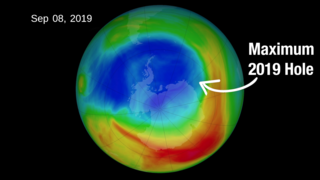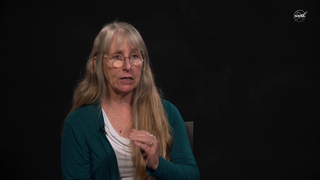Earth
ID: 12764
NASA and NOAA scientists work together to study the ozone layer, monitoring the hole over Antarctica as it fluctuates with the seasons.
This year, the ozone hole's annual maximum set a record -- the smallest it's been since 1988.
The hole in the ozone layer is caused each year as ozone molecules react with chlorofluorocarbons (CFCs) in the atmosphere. The reactions occur at cold temperatures, so the hole reaches a maximum size each year at the end of southern winter, and then heals during the warmer summer months.
Although CFCs have been banned since 1987 under the Montreal Protocol on Substances that Deplete the Ozone Layer, the compounds decay very slowly, and still remain in the atmosphere. This year, the small ozone hole was mostly caused by warmer temperatures, which slowed down the reactions between ozone and CFCs.
Warm Winter Air Makes for a Small Ozone Hole
This year, the ozone hole's annual maximum set a record -- the smallest it's been since 1988.
The hole in the ozone layer is caused each year as ozone molecules react with chlorofluorocarbons (CFCs) in the atmosphere. The reactions occur at cold temperatures, so the hole reaches a maximum size each year at the end of southern winter, and then heals during the warmer summer months.
Although CFCs have been banned since 1987 under the Montreal Protocol on Substances that Deplete the Ozone Layer, the compounds decay very slowly, and still remain in the atmosphere. This year, the small ozone hole was mostly caused by warmer temperatures, which slowed down the reactions between ozone and CFCs.
Related
Credits
Please give credit for this item to:
NASA's Goddard Space Flight Center
NASA's Goddard Space Flight Center
Short URL to share this page:
https://svs.gsfc.nasa.gov/12764
Keywords:
SVS >> HDTV
SVS >> Ozone Hole
SVS >> Ozone depletion
GCMD >> Earth Science >> Atmosphere >> Atmospheric Chemistry/Oxygen Compounds >> Ozone
SVS >> NOAA
SVS >> CFCs
NASA Science >> Earth
GCMD keywords can be found on the Internet with the following citation: Olsen, L.M., G. Major, K. Shein, J. Scialdone, S. Ritz, T. Stevens, M. Morahan, A. Aleman, R. Vogel, S. Leicester, H. Weir, M. Meaux, S. Grebas, C.Solomon, M. Holland, T. Northcutt, R. A. Restrepo, R. Bilodeau, 2013. NASA/Global Change Master Directory (GCMD) Earth Science Keywords. Version 8.0.0.0.0
https://svs.gsfc.nasa.gov/12764
Keywords:
SVS >> HDTV
SVS >> Ozone Hole
SVS >> Ozone depletion
GCMD >> Earth Science >> Atmosphere >> Atmospheric Chemistry/Oxygen Compounds >> Ozone
SVS >> NOAA
SVS >> CFCs
NASA Science >> Earth
GCMD keywords can be found on the Internet with the following citation: Olsen, L.M., G. Major, K. Shein, J. Scialdone, S. Ritz, T. Stevens, M. Morahan, A. Aleman, R. Vogel, S. Leicester, H. Weir, M. Meaux, S. Grebas, C.Solomon, M. Holland, T. Northcutt, R. A. Restrepo, R. Bilodeau, 2013. NASA/Global Change Master Directory (GCMD) Earth Science Keywords. Version 8.0.0.0.0













